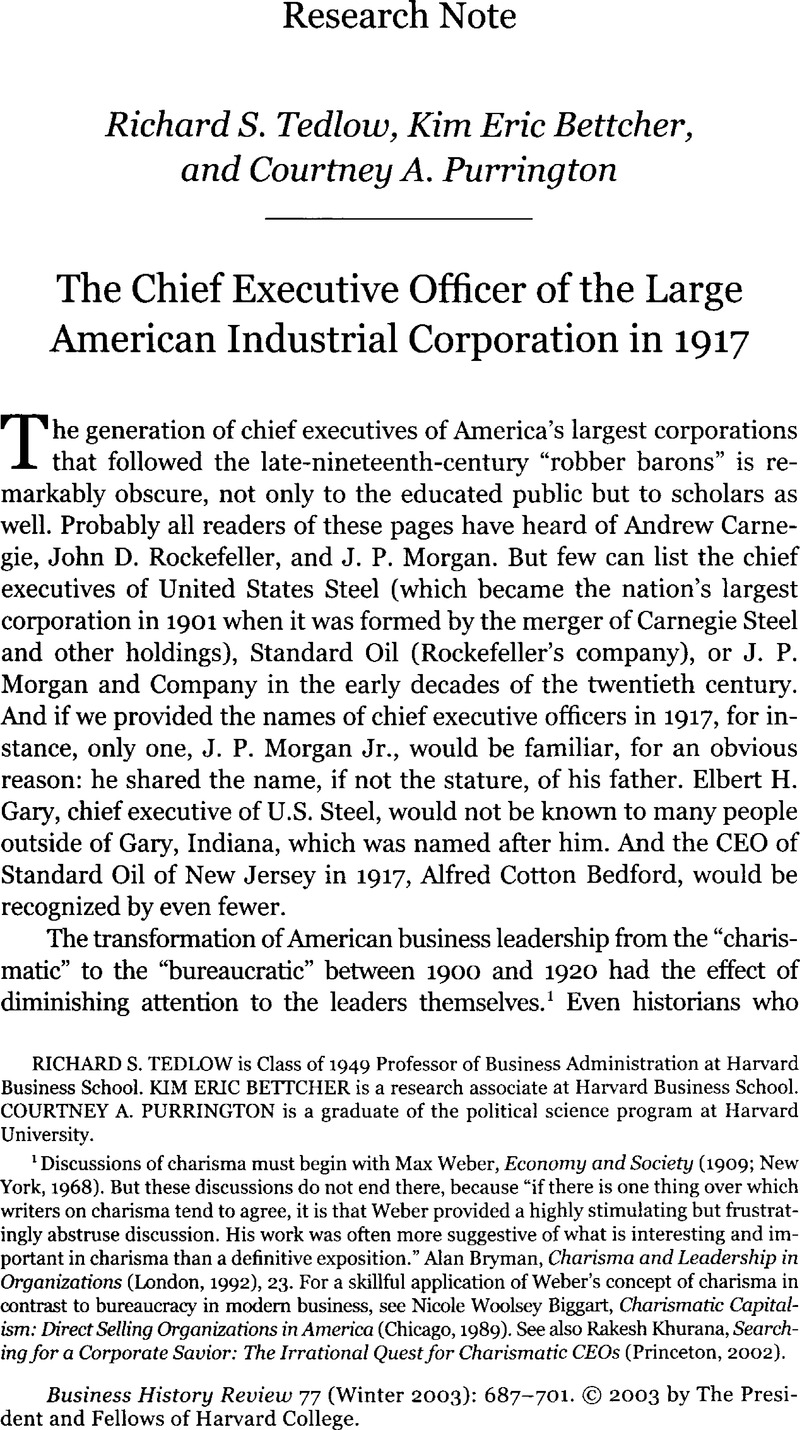Article contents
The Chief Executive Officer of the Large American Industrial Corporation in 1917
Published online by Cambridge University Press: 13 December 2011
Abstract

- Type
- Research Note
- Information
- Copyright
- Copyright © The President and Fellows of Harvard College 2003
References
1 Discussions of charisma must begin with Weber, Max, Economy and Society (1909; New York, 1968)Google Scholar. But these discussions do not end there, because “if there is one thing over which writers on charisma tend to agree, it is that Weber provided a highly stimulating but frustratingly abstruse discussion. His work was often more suggestive of what is interesting and important in charisma than a definitive exposition.” Bryman, Alan, Charisma and Leadership in Organizations (London, 1992), 23Google Scholar. For a skillful application of Weber's concept of charisma in contrast to bureaucracy in modern business, see Biggart, Nicole Woolsey, Charismatic Capitalism: Direct Selling Organizations in America (Chicago, 1989)Google Scholar. See also Khurana, Rakesh, Searching for a Corporate Savior: The Irrational Quest for Charismatic CEOs (Princeton, 2002)CrossRefGoogle Scholar.
2 Hofstadter, Richard, The American Political Tradition and the Men Who Made It (New York, 1974 [1948]), 213.Google Scholar
3 Quoted in Sklar, Martin J., The Corporate Reconstruction of American Capitalism, 1890-1916: The Market, the Law, and Politics (Cambridge, U.K., 1988), 16, n. 12CrossRefGoogle Scholar.
4 Sklar, Corporate Reconstruction, 16, n. 12.
5 Wiebe, Robert H., Businessmen and Reform: A Study of the Progressive Movement (Chicago, 1962), 17–18Google Scholar.
6 Elbert H. Gary was almost certainly the first industrial leader to be known officially as chief executive officer, as early as 1910. See U.S. Steel bylaws resolution quoted in Sevitch, Benjamin, “Elbert H. Gary: Spokesman for Steel” (Ph.D. diss., Indiana University, 1972), 36.Google Scholar
7 See Gordon, Robert Aaron, Business Leadership in the Large Corporation (Washington, D.C., 1945), 75 and 67-93Google Scholar; Chandler, Alfred D. Jr, Strategy and Structure: Chapters in the History of the American Industrial Enterprise (Cambridge, Mass., 1962), 52–113Google Scholar.
8 Navin, Thomas R., “The 500 Largest American Industrials in 1917,” Business History Review 44 (Autumn 1970): 360–86.CrossRefGoogle Scholar
9 Chandler, Alfred D. Jr, The Visible Hand: The Managerial Revolution in American Business (Cambridge, Mass., 1977)Google Scholar, and Scale and Scope: The Dynamics of Industrial Capitalism (Cambridge, Mass., 1990), app. A.1.Google Scholar
10 U.S. Steel, for example, had 275,000 employees in 1917. Forbes, Bertie C., Men Who Are Making America (New York, 1917), pp. 144–45CrossRefGoogle Scholar.
11 Not until 1920 did the U.S. Census classify more than 50 percent of the population as living in urban rather than rural territory; even then, the definition of “urban” was a town with a population as small as 2,500.
12 Edward A. Cudahy, Edward Laurence Doheny, Frederick F. Fitzpatrick, Stephen B. Fleming, Thomas Saxton Grasselli, Frank Norton Kondolf, Thomas J. Maloney, John Dennis Ryan, Charles Michael Schwab, and Harry Ford Sinclair.
13 Daniel Guggenheim, Harry Hart, Fred Hirschhorn, Julius Kessler, Solomon Guedalia Rosenbaum, Julius Rosenwald, and Adolph Zukor.
14 We do not wish here to engage in the long-standing debate concerning Protestantism and capitalism.The classic statement in this voluminous literature is Weber, Max, The Protestant Ethic and the Spirit of Capitalism (1930; New York, 1957)Google Scholar.
15 Other CEO data included in the study were career path to CEO, family business ties, military background, political party affiliation, education levels, colleges attended, and father's occupation.
- 1
- Cited by




